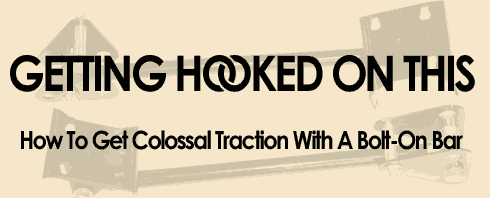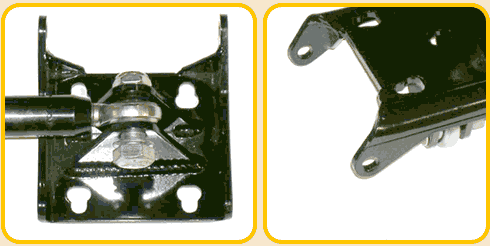| 
by Wayne
Scraba
Photos by Wayne Scraba
9/7/04
Plenty of early
passenger cars used leaf springs on the rear.
That makes bolting on rear traction devices
pretty simple. Unfortunately, simple doesn’t
necessarily mean adjustable. And in some cases,
simple doesn’t always work
that well either—especiaslly if your
car has some heat under the hood.

The Cal-Tracs
bar is designed to operate in a manner
different than a slapper bar. The idea
is to load the spring, and then transfer
the weight from the front to the rear
of the car. Installation is a basic bolt
in, however springs and shocks definitely
must be tailored to the application. |
One piece of equipment that might change all
of that is the Cal-Tracs bar. This piece has
seen use on a number of NHRA-legal stockers,
has seen great success on John Calvert’s
own Super Stock Mustang and is used regularly
on a host of fastest street cars and other quick
leaf spring applications.
In John Calvert’s case, talk about playing
with a stacked deck: Amidst a sea of 4-link,
14-inch wide X 33-inch tall tired, automatic
transmission Super Stock/GT cars Calvert campaigns
a stick shift stocker chassis—complete
with itsy-bitsy 9” slicks. But the combination
has been overwhelmingly successful, with a string
of national event wins (he was also the Winston
World Champ in stock eliminator in 1991). What
makes the car tick? It’s really not a
complex piece. Instead, it’s a basic stock
eliminator chassis that John Calvert began class
racing with over two decades ago (familiarity
with a car obviously has its merits).
 |
| At the rear of the bar (under the
spring seat) you’ll find this
is the rod end arrangement. The chrome
moly tube simply attaches to the spring
seat in this fashion. Both of the rod
ends on each bar are high end Aurora
pieces. |
|
| The spring seat is designed so that
the shocks can be mounted on either
side of the bar. If the shock mounts
on your car are staggered (one shock
ahead of the axle, one behind it) the
bar will still work. |
|
|